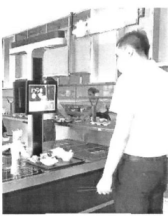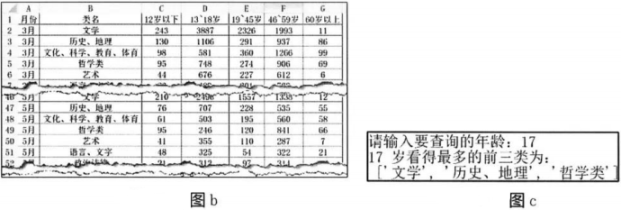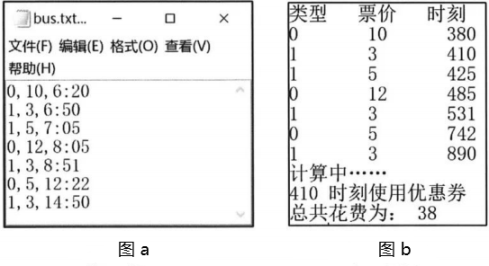某校打造智慧食堂,引入了智能结算系统。管理员通过网页平台进行师生账户管理、菜品管理、查询记录。师生在用餐前仅需将盛有菜的碗碟放到结算台,结算台的读写器读取碗碟中的电子标签信息并计算价格,摄像头采集到人脸信息,结算台的软件将人脸信息和消费价格一同发送给服务器,服务器进行人脸识别并返回扣费结果至结算台。

@app. route(" /index" )
def menu_ _list():
conn = sqlite3. connect("db. db" )
cur = conn. cursor( )
cur. execute("select * from menus")
food = cur. fetchall()
cur.close()
conn. close()
return render_ template("list.html", food = food)
下列说法不正确的是( )
 B .
B .  C .
C .  D .
D . 

def ugly(n):
for i in[2,3,5]:
while n % i==0:
n=n//i
return n == 1
若调用执行自定义函数ugly(30),下列说法正确的是( )
#读入链表,存储在列表a中,head存储链表的头节点
odd = head
even = a[odd][1]
tmp = even
while a[odd][1] != -1 and a[even][1] != -1:
![]()
a[odd][1] = tmp
上述程序段中方框处可选的语句为:
①odd = a[odd][1]
②even = a[even][1]
③a[odd][1] = a[even][1]
④a[even][1] = a[odd][1]
则方框处语句依次为( )
from random import randint
s ="python"
k = randint(1, 4)
for i in range(k):
j=i+1
while j < len(s) and s[j] > s[i]:
j+=1
if j < len(s):
s=s[:j]+s[j+1:]
else:
s = s[:1en(s) - 1]
print(s)
执行该程序段后,s的值不可能是( )

其过程包括以下步骤:①读写器向电子标签发送射频信号;②读写器采集电子标签的信息并解码;③读写器将相关信息传输到服务器;④电子标签向读写器发送编码信息。上述步骤正确的顺序是。

输入年龄,现需统计该年龄读者阅读最多的书籍类别(输出前三种)。程序运行结果如图c所示。实现上述功能的程序代码如下,请补充方框处的代码(可以使用一条或多条语句)。
import pandas as pd
age = int(input("请输入要查询的年龄: "))
age_ list = [[1, 12], [13, 18], [19, 45], [46, 59],[60,150]]
for i in range(len(age_ list)):
if age_ list[i][0] <= age <= age_ 1ist[1][1]:/
break
df = pd. read_ excel("books. xlsx")
age_ col = df. columns[i + 2] #获取年龄age对应的列名
df = df. drop("月份",axis=1)
![]()
print(age,"岁看得最多的前三类为: \n", list(res . index))

请回答下列问题:
def Ctime(t):
#自定义函数Ctime功能为将时间转为分钟计存入变量s,代码略。
return S
读取出行记录,存储在列表a中,a[i][0]、a[i][1]、a[i][2]依次存储交通工具类型、票价、乘坐开始时刻。交通工具类型a[i][0]值为0表示地铁,1表示公交车。代码略。
n = len(a)
for i in range(n):
a[i][2] = Ctime(a[i][2])
for i in range(n - 1):
for j in range(n - 1, i, -1):
if ![]() :
:
a[j], a[j - 1] = a[j - 1],a[j]
#输出出行记录,代码略。
total = 0
head=tail=0
q = [-1]*n
for i in range(n)
if a[i][0]==0
total+= a[i][1]
①
tail+= 1
else:
while head < tail and q[head] < a[i][2] - 45:
head += 1
if ②
total += a[i][1]
else:
print(a[i][2], "时刻使用了优惠券")
③
print("总共花费为:", total)
①②③

请回答下列问题:
随机选取n个圆盘,其半径与颜色分别存储在列表r和color中并输出,如图b所示,
r = [9,3,6,4,8,5], color = ['红','紫','蓝','绿','橙','红']。
n = 1en(r)
f= { } # f中键为颜色,值为该颜色的可见数量,如: {" 蓝":2}
def pop(top, cnum, rad):
while top!= -1 and rad >= r[z[top]]:
f[color[z[top]]] -= 1
if ①
cnum -= 1
top -= 1
return top, cnum
z=[-1]*n
top = -1
cnum=cmax=0
for i in range(n):
top, cnum = pop(top, cnum, p[i])
top += 1
②
if color[z[top]] not in f:
if[color[z[top]]= 1
cnum+= 1
else :
f[color[z[top]] += 1
if cnum >= cmax:
cmax = cnum
res = dict(f) #将此时的f另存到res中
m= ③
s=""
for i in res:
if res[i] > 0:
s +=i
print("拿走", m, "片后,可看到圆盘的颜色种数最多,分别为: ", s)
①②③